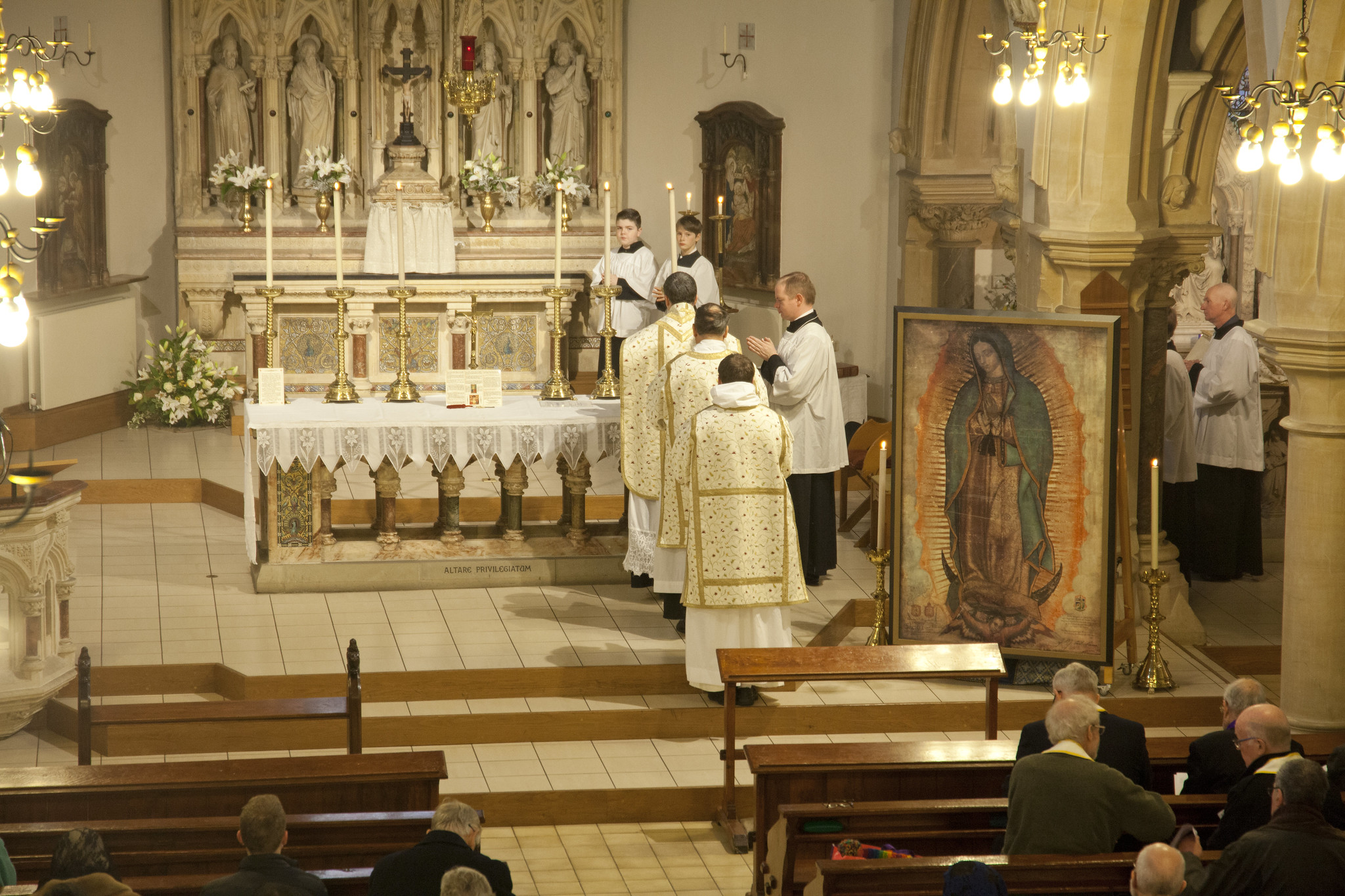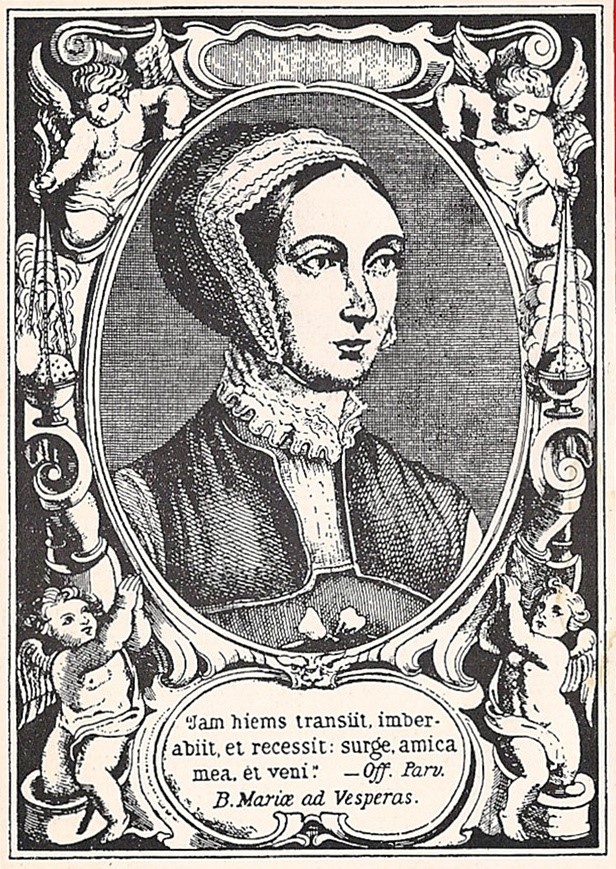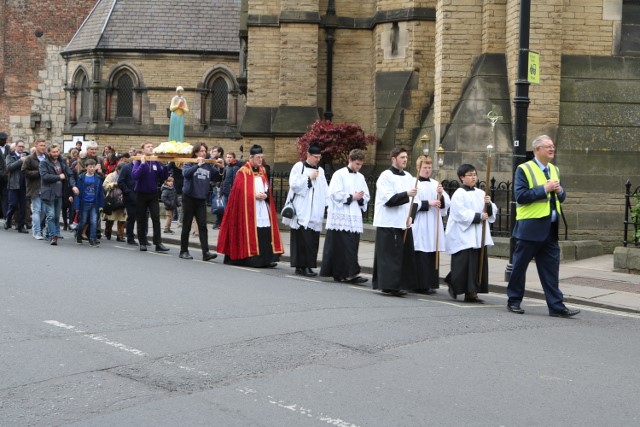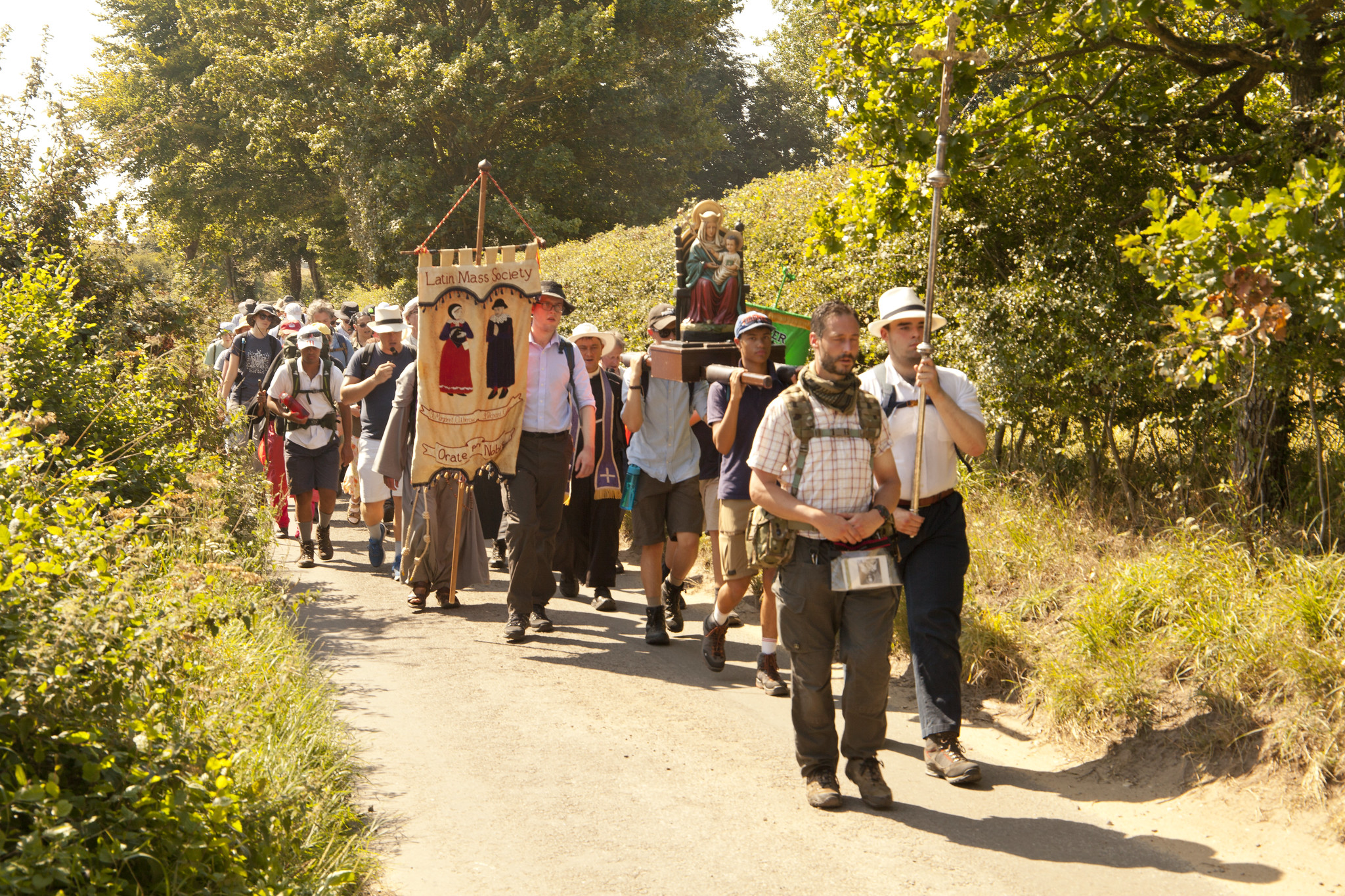LMS Pilgrimage to Oxford
The LMS’s annual pilgrimage in honour of the Catholics martyred in the city of Oxford in 1589 and 1610 takes place on a Saturday in mid October, and comprises a High Mass in the Dominican Rite in the Priory Church of the Holy Spirit, Blackfriars (St Giles, OX1 3LY) followed by a procession to one of the sites of martyrdom, and Benediction.
The Martyrs of 1589
Bl George Nichols and Bl. Richard Yaxley, both secular priests, had been trained at Rheims. Nichols had studied at Brasenose College, Oxford, and became famous as the priest
who was smuggled in to Oxford Castle to reconcile a highwayman to the Church on the eve of the latter’s execution.
Bl. Thomas Belson was a layman, a member of a Catholic land-owning family based in Ixhill, over the county border in Buckinghamshire.
Bl Humphrey Prichard was a Welshman, an employee of the Catherine Wheel Inn, which was situated on the corner of Broad Street and Magdalen Street (where part of Balliol College now stands) opposite the church of St Mary Magdalene.
The four were captured in the Catherine Wheel, taken to London to be tortured, and tried and executed in Oxford. The place of execution was the Town Gallows, outside the corner of the town walls still preserved in New College, approximately where 100 Holywell Street now stands, which is marked by a plaque in their honour.
In 2008, during the LMS Pilgrimage, Bishop William Kenney blessed a new plaque marking the site of the martyrdoms of 1589, on behalf of Archbishop Vincent Nichols, during the LMS Pilgrimage that year.
The Martyrdom of 1610
Bl George Napier was born in Holywell Manor in Oxford in 1550; he attended Corpus Christi but as a Catholic could not take a degree. He was ordained at Douai and returned to minister to Catholics in the Oxford area in 1603. He was captured and executed in 1610, on the Castle Gallows.
Since the Castle complex has been redeveloped, the site is now accessible to the public, and the spot is marked by a steel plaque. This was blessed in the course of the LMS Pilgrimage by Archbishop Bernard Longley in 2010.
More from the Catholic Encyclopedia here.
English Martyrs Pilgrimage, Preston
The LMS's annual pilgrimage in honour of the English Martyrs usually takes place in May, around the Feast of the English Martyrs, and is in association with the Institute of Christ the King Sovereign Priest. It begins with an assembly at St Walsburge’s Church for devotions at noon. Subsequently, a procession with banners to English Martyrs Church takes place and High Mass is celebrated upon arrival. Afterwards, Pilgrims relax whilst having tea in the Parish Hall before heading home.
The English Martyrs are a group of Catholic lay and religious, men and women, executed at the end of the 16th century to the mid-17th century for choosing to remain faithful to the Catholic Church, rather than kowtowing to the various laws enacted by Parliament during the English Reformation which were passed to destroy the Catholic Church in England.
Left Photo: 40 Martyrs of England and Wales
Right Photo: LMS English Martyrs Pilgrimage 2018


Mass of Reparation for Abortion, Bedford
By kind invitation of the Shrine of Our Lady of Guadalupe in Bedford, the LMS co-organises a High Mass, usually in late November, which is offered in reparation for all abortion carried out.

Our Lady of Guadalupe is the patron saint of the pro-life cause because the image of Our Lady that appeared inside the cloak of Juan Diego shows her pregnant with the Holy Infant Jesus. Her pregnancy can be identified by the black ribbon she had fastened around her waist, traditionally worn by pregnant women in Mexico during the 1500’s. Many miracles have been attributed to this cloak. Source
Photo: Mass of Reparation 2018
Chideock Martyrs
Held in September, the pilgrimage to Chideock Martyrs Parish begins with a walk on the private grounds and a view of the church. Mass then takes place, followed by the veneration of some of the relics of the martyrs. A tour and history of the Chideock Martyrs is given, followed by lunch.
 This pilgrimage is made to commemorate the seven men who died a martyr's death, and the eighth who died in prison, all persecuted for the faith during the 16th century. The martyrs were Fr Thomas Pilchard, a chaplain responsible for many converts; Blessed John Cornelius, a chaplain and friend to the Arundells in Chideock Castle who was betrayed by a servant whist hiding there; Blessed Hugh Green, a chaplain who had been arrested while attempting to flee to France; William Pike, a carpenter in Chideock; Thomas Bosgrave, the nephew of Lady Arundell who died trying to save Fr Cornelius (previously mentioned); Patrick Salmon, servant of Lady Arundell who also died trying to save Fr Cornelius; and John Jessop, imprisoned for his faith and died there.
This pilgrimage is made to commemorate the seven men who died a martyr's death, and the eighth who died in prison, all persecuted for the faith during the 16th century. The martyrs were Fr Thomas Pilchard, a chaplain responsible for many converts; Blessed John Cornelius, a chaplain and friend to the Arundells in Chideock Castle who was betrayed by a servant whist hiding there; Blessed Hugh Green, a chaplain who had been arrested while attempting to flee to France; William Pike, a carpenter in Chideock; Thomas Bosgrave, the nephew of Lady Arundell who died trying to save Fr Cornelius (previously mentioned); Patrick Salmon, servant of Lady Arundell who also died trying to save Fr Cornelius; and John Jessop, imprisoned for his faith and died there.
Photo: Chideock Martyrs Catholic Church, Chideock
Holywell
The LMS's annual Pilgrimage to Holywell, in association with the ICKSP, takes place on the first Sunday of July. High Mass is celebrated in St Winefride’s parish church, followed by a rosary procession to St Winefride's Well, where the relic of St Winefride is presented for veneration.
Around the year 630, Caradoc, a chieftain from Hawarden, attempted to seduce Winefride, the daughter of a prince. She ran from him and headed towards the church which had been built by her saintly uncle. Caradoc caught up with her and cut off her head. A spring of water came up in the place where her head fell (the well). Her uncle came out of the church and placed her head back on her body. After praying over her, she was raised to life and Caradoc sank into the ground, never to be seen again. Winefride became a nun and later an Abbess. A white scar around her neck remained as a sign of her martyrdom.
Left Photo: St Winefride stain glass window
Right Photo: Rosary Procession to the Well 2018


St Margaret Clitherow & York Martyrs
The LMS takes part in the annual pilgrimage to honour St Margaret Clitherow and the York Martyrs, which is organised by the Fathers of the York Oratory (St Wilfrid). The day begins with an assembly at the Bar Convent to venerate the Relic of St Margaret Clitherow. Then a procession with the statue of St Margaret moves off and passes Ouse Bridge (the place of her execution) and the Shambles (stopping at the house where she lived). After pilgrims arrive at St Wilfrid’s Church approximately an hour later, High Mass is celebrated, followed by Solemn Benediction.
Most well-known of the York Martyrs, Margaret Clitherow was born in 1556 and married a prosperous butcher in 1571. She became a Catholic three years later at the age of 18. Against the Law, she housed priests and ran a small school that taught the Catholic Faith to children. In 1586 she was betrayed to the authorities and was crushed to death on Good Friday because she refused to plead, which would have betrayed her family and friends. St Margaret is known as “the Pearl of York”.
Left Photo: St Margaret Clitherow
Right Photo: LMS St Margaret Clitherow and York Martyrs Pilgrimage


Walsingham
A pilgrimage inspired by our Medieval predecessors, the Chartres Pilgrimage, and similar events around the world today, the LMS Walsingham Pilgrimage consists of walking the 59 miles from Ely to Walsingham, with overnight stops en route. Participants attend Traditional Masses, as well as pray the Rosary, traditional devotions, chants, hymns and songs, to honour to Our Lady of Walsingham and to pray for the conversion of England.
The pilgrimage starts with registration in Ely on the Thursday before the August Bank Holiday. The walk commences early Friday morning, with pilgrims arriving at the Basilica of Our Lady of Walsingham Sunday lunchtime, in time for High Mass in the Chapel of Reconciliation. Pilgrims then have the opportunity to walk the Holy Mile into Walsingham village, where devotions are offered in the ruins of the original Priory.
Accompanied by priests, seminarians, and religious, High Masses are said on Friday, Saturday, and Sunday. A Sung Mass in the Medieval Slipper Chapel is also said on Monday for those staying the extra night.
Pilgrims are given specially created, re-usable Pilgrim’s Handbook with Mass texts, prayers, devotions, chants, and hymns for the road. Proper evening meals created by the dedicated cooking team are provided, as well as support vehicles accompanying the Pilgrimage to carry heavy baggage and collect tired pilgrims. Also provided are lifts, minibus, or coach to and from Ely, Walsingham, and London at the beginning and end of the Pilgrimage.
Our Lady of Walsingham appeared to Lady Richeldis de Faverches in a series of visions in 1061. In these visions, Richeldis was shown Our Lady’s house in Nazareth where the Annunciation took place. Our Lady asked Richeldis to build a replica of this holy house in Walsingham. As English Christians were unable to visit the Holy Land because of the Crusades during that time, they were now able to visit ‘Nazareth’ in their own country. The site became a shrine to Our Lady and a large monastery grew around it. It has attracted numerous pilgrims throughout the centuries and is one of the best known English pilgrimage sites.
Left Photo: Our Lady of Walsingham statue
Right Photo: LMS Walsingham Pilgrimage 2019


